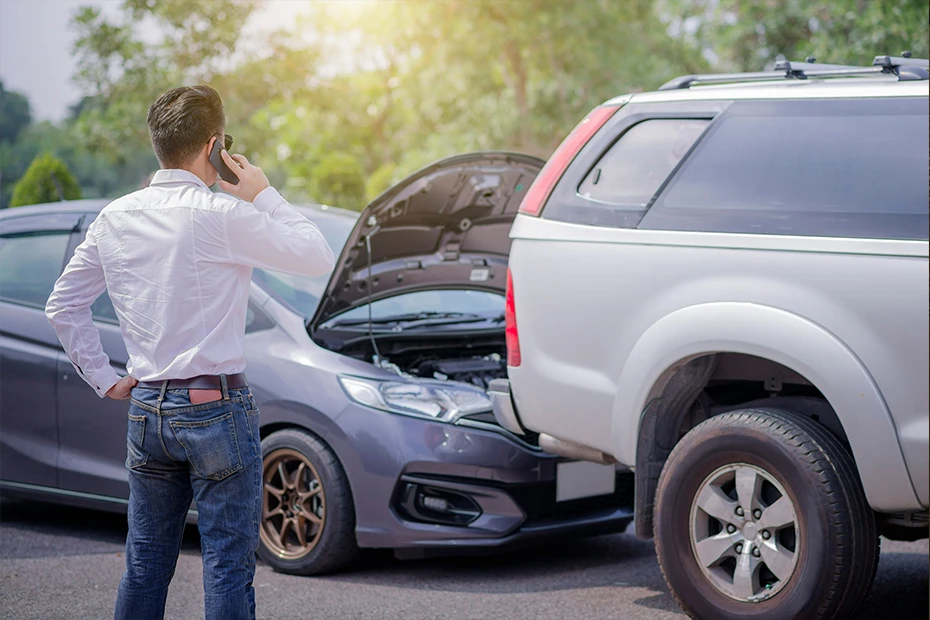An insurance claim is an official request that a policyholder makes to the insurance company for the compensation of the damage incurred by them. The compensation is provided as per the coverage guaranteed to the policyholder by the insurance company under the insurance agreement.
An insurance claim can be made in 2 ways - in a cashless manner and in a reimbursement manner. In case of car insurance, when a policyholder gets their car repaired at a partner garage of the insurance company, then the claim is settled in a cashless manner as the insurance company pays directly for the incurred repair expenses to the garage.
However, if the policyholder gets their car repaired at a garage which is not a part of the insurance company's request, then the policyholder needs to make the payment of the repair expenses themselves to the garage and the same is later reimbursed to the policyholder by the insurance provider, subject to the sum insured.
Car Insurance Claim Procedure - Driving a car on the road lets you travel miles, but it requires the driver to be responsible. Despite being cautious mishaps can happen at any point in time on the road. It can be an accident, theft, fire, or any other unfortunate event. To claim all the benefits of an insurance company, you need to contact your insurance agent or company immediately.
Please note, that you can claim benefits for damages and other causes depending upon the nature and coverage of your car insurance policy.

Documents Required To Process Car Insurance Claim
The car insurance claim settlement process requires the policyholder to submit certain documents in order to validate and accept the claim car insurance. You need to fulfill the insurance claim document along with the submission of the necessary documents. These are the following documents required in the claim settlement process.
- Copy of the insurance policy
- First Information Report (FIR) filed with the police station
- Copy of the driver's license
- Copy of the registration certificate of the car
Additional documents in case of reimbursement claim
- A brief estimate of the repairs
- Medical report in case of physical injuries
- Original records of other expenses
6 Easy Steps For Making Car Insurance Claim After an Accident
How to claim car insurance? To get the maximum benefits from your car insurance policy, inform about the accident and the intensity of the damage immediately to your car insurance company and of course, to the police.
If your insurance company finds your claim to be genuine, they will reimburse the amount after inspecting your vehicle or other aspects. Here are some steps to help you claim for your damages successfully -
Step 1: Inform The Insurance Company
Call your car insurance company immediately and intimate them about the incident in the first place. As the timeline is restricted, within the seven working days, you need to inform the insurer regarding the accident, failing which your claim settlement period is considered lapsed. To raise a claim, you need to submit vital documents like softcopies of your driving license, car registration certificate, FIR along with the first two pages of your insurance policy. You might also need a detailed letter addressed to the Road Transport Office (RTO).
Step 2: Lodge An FIR In The Nearest Police Station
Inform the police and file an FIR as this is a mandatory step in the car claim settlement process in events like theft, fire, or road accident, including the third party damage. The FIR can be avoided in situations where there are dents and scratches on the vehicle. It is a must when there is any physical injury or third party accidents. The police will visit the spot to identify the faults and make a clear distinction of whether the accident happened due to mechanical failure or not. It will also record all the essential details of the driver, the vehicle, passengers, and witnesses or other aspects in the FIR.
Additionally, you need to file a case to the Motor Accident Claims Tribunal having jurisdiction area where the accident happened between you and the third party. It is only required when a third party is involved in an accident.
Step 3: Capture Photographs As Valid Proof
Some people prefer to proceed with a reimbursement claim. In these type of cases capturing the scene of the events with a photograph can be helpful. You can snap a few pictures of the accident which involve your car damages, bodily injuries etc., and serve as valid proof during claim settlement. Besides, you can note down the name, contact number of your witnesses, third party (if any involved) so that it can help you in the entire procedure.
Step 4: Submit All The Documents To The Insurer
The next step after the FIR is to proceed towards claim settlement. It can only be initiated once you submit all the crucial document to the insurance company. Make sure to submit all the copies of documents like driving licence, car registration certificate, FIR, and other required information.
Step 5: Ask The Insurance Company To Send A Surveyor
File a claim from your insurance company and ask them to assign you with a surveyor, to begin with, a thorough inspection process. You can also raise the claim online by visiting the website or other web portals of the insurance company if they provide any such facility. In case of a cashless claim settlement, a representative will be sent by the insurance folks who will try to asses all the significant damage that has been incurred to your car. He will assist with the right network of the garage where your car can probably be towed down. Towing by the insurance company will be done to ensure that there are no further damages on the vehicle. The survey typically takes places within one-two working day of the car insurance claim intimation.
Step 6: Car Repairs
Get you car repaired and initiate the claim process. The claim settlement can be done in two processes. If someone prefers a cashless claim, then they do not require to bear the burden of repairing cost. In such cases, it is recommended to take the vehicle in the list of network garages prescribed by the insurance company. The policyholder only needs to pay for deductibles and the rest is covered by the insurer. On the other hand, if someone proceeds with reimbursement claim, he/she needs to pay from his own pocket for all the damages. In this case, he must submit original bills, receipts, medical reports, photographs, etc.to the insurance company. The insurer will reimburse all the repair amount after subtracting all the deductibles. Here the policyholder can repair his car at the preferred garage.
After it finds your claim to be genuine, your car insurance company will reimburse the amount as per the terms and conditions mentioned in your insurance cover. The amount to be reimbursed and the events to be covered would also depend on the type of car insurance policy you hold. The third-party insurance is mandatory in India according to the Motor Tariff Act 2002, and it will only incur the cost of damages owing to the involvement of a third party. The comprehensive car policy gives a broader coverage under a single umbrella, and you can also enhance it further with extended add-ons.
The process of claim settlement can be a little complicated, and therefore, it is suggested that policyholders should read the policy documents carefully, that the insurance company sends. All inclusions and exclusions reports will be provided in detail. A third opinion from a lawyer can also be taken in this regard.
Points to Remember After A Car Accident to Raise A Claim
No matter how much you know about the claim process of your insurance company. Some points are crucial after an accident or a mishap to keep in mind that ensures a hassle-free claim settlement process for you. Here are some points which you should remember after a car accident to make a successful claim:
- Immediately check yourself and your car after an accident to confirm and determine whether any major bodily injuries or damage is sustained by you or the insured car. Based on the level of damage or injury, you can call for medical assistance or any other support.
- Raise the claim for damage within a stipulated time set by your insurance provider, which is generally within 24 hours of the accident. Delay in raising a claim can lead to its rejection.
- Try to note down the registration number of the car, make, model and variant of the car, and/or colour of the car that is involved in the collision or accident to catch the culprit or raise the claim in a better and successful manner.
- Conversate with the eye witnesses who were present at the location of the accident and note down their names and contact details so you can get in touch with them in the future to confirm the person or persons responsible for the mishap or the accident.
- In case you find that accidental damage caused to the insured car is minor, in such a case, you can avoid raising a claim to secure your no claim bonus. You should assess this type of situation at the earliest and take immediate action accordingly.
- You should not get involved in any type of brawl after the accident with a third party person. Doing so can create unnecessary trouble for you in the future.
- Do not make any statement or share any information with the police or your insurance company if you are not sure about it or unless you are not confirmed about your next steps.
- Move your insured car away from the spot of the accident spot to get it repaired or for any related purpose only after getting permission from the police and your insurance provider.
- Keep all the required documents handy as you may have to submit several documents before the insurance company for the settlement of the claim with the duly filled and signed claim form. You may also need to produce some documents before the surveyor during the inspection of your car.
- If your insurance company provides the cashless claim facility, in such a case, you can take your car to a network garage for repair where you can get it repaired without paying anything from your pocket. In such situations, the garage will be paid for directly by your insurer.
Disclaimer: This article is issued in general public interest and meant for general information purposes only. Readers are advised not to rely on the contents of the article as conclusive in nature and should research further or consult an expert in this regard.



